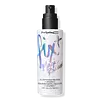What's inside
What's inside
 Key Ingredients
Key Ingredients

 Benefits
Benefits

 Concerns
Concerns

 Ingredients Side-by-side
Ingredients Side-by-side

Water
Skin ConditioningVinyl Dimethicone/Methicone Silsesquioxane Crosspolymer
Acrylates Copolymer
Pentylene Glycol
Skin ConditioningPvp
Emulsion StabilisingPolyglyceryl-10 Myristate
Skin ConditioningNiacinamide
SmoothingBakuchiol
AntimicrobialLens Esculenta Seed Extract
Skin ProtectingHamamelis Virginiana Leaf Extract
Skin ConditioningXanthan Hydroxypropyltrimonium Chloride
HumectantSodium Hyaluronate
HumectantButylene Glycol
HumectantEthylhexylglycerin
Skin ConditioningSodium Dehydroacetate
PreservativePhenoxyethanol
PreservativeWater, Vinyl Dimethicone/Methicone Silsesquioxane Crosspolymer, Acrylates Copolymer, Pentylene Glycol, Pvp, Polyglyceryl-10 Myristate, Niacinamide, Bakuchiol, Lens Esculenta Seed Extract, Hamamelis Virginiana Leaf Extract, Xanthan Hydroxypropyltrimonium Chloride, Sodium Hyaluronate, Butylene Glycol, Ethylhexylglycerin, Sodium Dehydroacetate, Phenoxyethanol
Water
Skin ConditioningButylene Glycol
HumectantGlycerin
HumectantPolysorbate 20
EmulsifyingTocopheryl Acetate
AntioxidantSodium Hyaluronate
HumectantArginine
MaskingCaffeine
Skin ConditioningAspergillus Ferment
Skin ConditioningRosa Rubiginosa Seed Oil
EmollientPorphyra Yezoensis Extract
Skin ConditioningGentiana Lutea Root Extract
Skin ConditioningPalmaria Palmata Extract
Skin ProtectingAlgae Extract
EmollientYeast Extract
Skin ConditioningHydrolyzed Rice Bran Extract
Skin ConditioningDipotassium Glycyrrhizate
HumectantSodium Polyaspartate
HumectantSilk Powder
Skin ConditioningPhospholipids
Skin ConditioningAscorbyl Glucoside
AntioxidantSalicylic Acid
MaskingTrehalose
HumectantTourmaline
Jojoba Wax PEG-120 Esters
Potassium Hydroxide
BufferingCaprylyl Glycol
EmollientHexylene Glycol
EmulsifyingPentylene Glycol
Skin ConditioningCitric Acid
BufferingHydroxyethyl Urea
HumectantParfum
MaskingLimonene
PerfumingBHT
AntioxidantDisodium EDTA
Sodium Citrate
BufferingPhenoxyethanol
PreservativePotassium Sorbate
PreservativeChlorphenesin
AntimicrobialSodium Benzoate
MaskingWater, Butylene Glycol, Glycerin, Polysorbate 20, Tocopheryl Acetate, Sodium Hyaluronate, Arginine, Caffeine, Aspergillus Ferment, Rosa Rubiginosa Seed Oil, Porphyra Yezoensis Extract, Gentiana Lutea Root Extract, Palmaria Palmata Extract, Algae Extract, Yeast Extract, Hydrolyzed Rice Bran Extract, Dipotassium Glycyrrhizate, Sodium Polyaspartate, Silk Powder, Phospholipids, Ascorbyl Glucoside, Salicylic Acid, Trehalose, Tourmaline, Jojoba Wax PEG-120 Esters, Potassium Hydroxide, Caprylyl Glycol, Hexylene Glycol, Pentylene Glycol, Citric Acid, Hydroxyethyl Urea, Parfum, Limonene, BHT, Disodium EDTA, Sodium Citrate, Phenoxyethanol, Potassium Sorbate, Chlorphenesin, Sodium Benzoate
Ingredients Explained
These ingredients are found in both products.
Ingredients higher up in an ingredient list are typically present in a larger amount.
Butylene Glycol (or BG) is used within cosmetic products for a few different reasons:
Overall, Butylene Glycol is a safe and well-rounded ingredient that works well with other ingredients.
Though this ingredient works well with most skin types, some people with sensitive skin may experience a reaction such as allergic rashes, closed comedones, or itchiness.
Learn more about Butylene GlycolPentylene glycol is typically used within a product to thicken it. It also adds a smooth, soft, and moisturizing feel to the product. It is naturally found in plants such as sugar beets.
The hydrophilic trait of Pentylene Glycol makes it a humectant. As a humectant, Pentylene Glycol helps draw moisture from the air to your skin. This can help keep your skin hydrated.
This property also makes Pentylene Glycol a great texture enhancer. It can also help thicken or stabilize a product.
Pentylene Glycol also acts as a mild preservative and helps to keep a product microbe-free.
Some people may experience mild eye and skin irritation from Pentylene Glycol. We always recommend speaking with a professional about using this ingredient in your routine.
Pentylene Glycol has a low molecular weight and is part of the 1,2-glycol family.
Learn more about Pentylene GlycolPhenoxyethanol is a preservative that has germicide, antimicrobial, and aromatic properties. Studies show that phenoxyethanol can prevent microbial growth. By itself, it has a scent that is similar to that of a rose.
It's often used in formulations along with Caprylyl Glycol to preserve the shelf life of products.
Sodium Hyaluronate is hyaluronic acid's salt form. It is commonly derived from the sodium salt of hyaluronic acid.
Like hyaluronic acid, it is great at holding water and acts as a humectant. This makes it a great skin hydrating ingredient.
Sodium Hyaluronate is naturally occurring in our bodies and is mostly found in eye fluid and joints.
These are some other common types of Hyaluronic Acid:
Learn more about Sodium HyaluronateWater. It's the most common cosmetic ingredient of all. You'll usually see it at the top of ingredient lists, meaning that it makes up the largest part of the product.
So why is it so popular? Water most often acts as a solvent - this means that it helps dissolve other ingredients into the formulation.
You'll also recognize water as that liquid we all need to stay alive. If you see this, drink a glass of water. Stay hydrated!
Learn more about Water